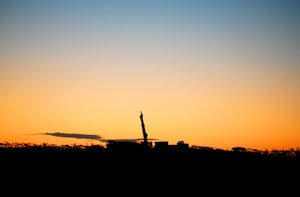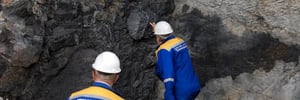Ferro Alloy Resources Limited (LON:FAR), the vanadium mining and processing company with operations based in Southern Kazakhstan, has announced that it has today entered into a subscription agreement for up to US$12.6m with Vision Blue Resources, a company led and founded by former Xstrata CEO Sir Mick Davis, and a limited number of co-investors. Sir Mick Davis will join the Company’s board as Chairman following completion of the Initial Investment outlined in the Subscription Agreement. Chris Thomas, current Chairman of FAR, will resume the role of Non-Executive Director on Sir Mick Davis’s appointment.
Highlights
· Total funding package of up to US$12.6m at a subscription price of 9 pence per share (the “Issue Price”) comprises:
o An initial investment in two stages of up to US$3.1m by VBR, a company led by Sir Mick Davis, and the Co-Investors including Tony Trahar, former CEO of Anglo American plc (the “Initial Investment”)
o Further investment rights granted to VBR of up to US$9.5m at the Issue Price (the “Further Investment Rights”)
· Transaction structure provides a pathway to VBR to acquire 21.29% of FAR for U$11.5m of the total funding package
· Proceeds of the total funding package will be used to:
o Complete the expansion of the existing, cashflow generating, processing facilities
o Complete the Bankable Feasibility Study (“FS”) on the Company’s large scale, low cost Balasausqandiq Vanadium Project (“Balausa Project”)
· Establishment of a strategic relationship with VBR through:
o Additional future investment rights tied to construction milestones at the Balausa Project of up to US$30m at higher share prices
o Sir Mick Davis to be appointed Chairman of the Board
o Offtake rights granted to VBR, upon VBR’s and the Co-Investors’ investment totalling in aggregate at least US$10.0m, to purchase up to 25% of all vanadium bearing materials produced annually by the Group at market prices
o Conditional right for VBR to make further Board Non-Executive Director appointments
o An agreement and joint initiative to recruit additional members to the management team to ensure that the necessary skills and leadership are in place to take the Balausa Project into production.
Nick Bridgen, Ferro-Alloy Resources CEO commented:
“I am delighted to announce a multi-stage strategic investment into Ferro Alloy Resources by Vision Blue, led by Sir Mick Davis, as well as his proposed appointment as Chairman of the Board. Sir Mick brings to the Company a wealth of knowledge of the mining industry, extensive strategic experience, and relationships which will play an important role in helping the Company achieve the high value potential of the Balausa Project.
“This investment package will allow us to complete our planned expansion of the existing operation and complete the Balausa Project feasibility study. Thereafter, further investment is staged to fund the development of the main Balausa Project. With this robust backing, we can now make rapid progress on all fronts.”
Sir Mick Davis commented:
“The Ferro Alloy Resources investment case is compelling, has an attractive risk profile and many qualities that are difficult to find in other mining investment opportunities. The Balausa Project has the potential to become the lowest cost producer of vanadium globally and to deliver highly attractive returns to its shareholders. This long-life asset benefits from access to excellent existing power and logistics infrastructure and has clear potential to achieve net-negative cash production costs – a unique quality in this industry.
“The strong investment case for vanadium is clear not only from a steel demand perspective, but even more when considering the huge potential for vanadium redox batteries to play an integral role in the establishment of reliable ‘base-load’ renewable energy, capable of reducing the world’s reliance on fossil fuels. The Balausa Project is especially attractive in this respect given its production cost profile and the team’s conservative long term price assumptions.
“I would like to thank Chris Thomas for Chairing the Board over the last two years and look forward to working with him and the rest of the Board and management team following my appointment.
There are multiple near-term catalysts for the Company and I expect to see significant progress in the coming months.”
Chris Thomas, Chairman, commented:
“I am delighted to hand over to Sir Mick Davis as Chairman and, following his appointment, return to the role of Non-Executive Director.
“Mick shares the Board’s vision for the business and fully supports our plan to deliver its potential. He and his partners bring not just personal financial commitment but also deep experience of the capital markets and expertise in the vanadium sector.
“We believe Sir Mick’s involvement will accelerate the progress of the company. I am more excited than ever about the prospects for FAR and look forward to working with Sir Mick and the rest of the board to bring the Balausa Project to fruition.”
Ferro went on to provide a production and operations update for the year ended 31 December 2020 at its existing vanadium concentrate processing operation.
Highlights:
· 56% increase in vanadium pentoxide production in 2020 to 237 tonnes
· Production of calcium molybdate commenced in October 2020 providing an additional revenue stream
· Installed and commissioned equipment during 2020 to increase plant capacity to around 80 tonnes of vanadium pentoxide per month, six times more than 2019 including:
o pyrometallurgical section completed
o three new press filters installed
o oven for conversion of AMV* to vanadium pentoxide
o Increases in capacity of leaching stages
o roaster for pre-roasting of concentrates installed
· Connection to high voltage line progressing, completion scheduled for May 2021, currently nearly 80% complete
· Developed and patented highly efficient process for production of electrolyte from ammonium metavanadate – process tested and samples created
· Feasibility study to western bankable standards progressing
Nick Bridgen, CEO, said: “During 2020 Ferro-Alloy continued to make significant progress, despite the ongoing Covid-19 pandemic restricting the movement of people and equipment to the site and other knock-on effects on our suppliers of raw-materials and equipment. Nevertheless, we saw a significant increase in production of vanadium pentoxide in the year and an even greater increase in capacity. Future production should improve strongly with the lessening of Covid-19 restrictions and the connection to the reliable high voltage power line.
“Our technical team made great progress during the year. The speed at which we developed the technology to produce calcium molybdate was particularly encouraging. This addition to the Existing Operation will prove an important revenue stream and at little extra cost. In addition, the development of a technology to produce electrolyte for vanadium flow batteries directly from ammonium metavanadate was impressive and will allow the Company to take part in the ever-growing renewables market.
“The Existing Operations are a stepping stone to the much larger vanadium project. With continuing progress on the upgrade of the feasibility study, it is important to remind investors of the huge size and unique ore of the Balasausqandiq Vanadium Project which we believe has the potential to become the world’s largest and lowest cost vanadium mine.”
Vanadium pentoxide production
During the year ended 31 December 2020, production of vanadium pentoxide (V2O5) amounted to 237 tonnes, some 56% above 2019. Whilst this is a very solid increase, without the disruptions experienced due to the Covid-19 pandemic and previously reported interruptions to power supply, production would have been significantly higher.
| Quarter (2020) | Production of Vanadium Pentoxide(tonnes of vanadium pentoxide contained in AMV*) | Growth vs last year | Production of Molybdic Oxide(tonnes of molybdic oxide contained in calcium molybdate) |
| Q1 | 49.1 | +53% | – |
| Q2 | 48.9 | +25% | – |
| Q3 | 89.8 | +135% | – |
| Q4 | 49.5 | +15% | 12.0 |
| 2020 total | 237.3 | 56% | 12.0 |
* AMV: ammonium metavanadate
The focus of the Existing Operation during 2020 was the commissioning and expansion of the new pyrometallurgical process line which is designed to treat a different type of concentrate from that which was previously treated.
In February, the second roasting oven was installed and the pyrometallurgical line completed. Over the course of H1 2020 this new process became the most important contributor to production, bringing the total capacity of the combined plant to some 80 tonnes per month depending on the grades of concentrates treated, six times more than 2019 production. Actual production has lagged significantly behind this level as a result of both Covid-19 restrictions, which have affected both the Company and its suppliers, and continuing power supply issues. It is expected that the connection to the adjacent high-voltage power-line will take place during May 2021, further details of which are set out below.
The impact of Covid-19 has been seen particularly in the more technically difficult hydrometallurgical production process which has been temporarily halted several times, primarily as a result of the inability to bring specialist staff to site. This has resulted in some five months of lost production from this part of the operation. The Company has prioritised the pyrometallurgical operations, not only because it is technically simpler, but also because the prices paid for the raw materials flex with the vanadium price so margins are less affected by low prices than for the hydrometallurgical line where the price is fixed.
The Covid-19 travel bans have also made installation, commissioning and fault rectification much more difficult. The Company has, using substantially its own workforce, completed commissioning work on two of the three new press filters which would normally have required site visits from the suppliers, and completed the installation of the oven to convert ammonium metavanadate to vanadium pentoxide. The oven is currently in part-time operation for the production of calcium molybdate and will be used for its intended purpose once the gas scrubbing equipment is installed. The third new press filter, which was never properly commissioned since installation at the beginning of the lock-down, is only now being brought into operation by our own team using remote instructions from the supplier’s specialist programmers.
Production in the fourth quarter was disappointing, with little contribution from the hydrometallurgical line and restricted deliveries from the Company’s main high-grade concentrate supplier, attributed to the effects of the Covid-19 restrictions on their operation.
Production outlook
Although the progression to higher production slowed towards the end of 2020, the equipment is now in place to achieve significantly higher production, assisted by the near-term connection to the high-voltage power-line and as the global vaccination programme starts to lessen the restrictions caused by the Covid-19 pandemic.
As disclosed above, supplies of raw materials continued to be restricted below contracted levels and this continued into January and February 2021, attributed to Covid-19 related restrictions. In the near term, this now shows signs of returning to more normal levels and future production should improve.
Looking further ahead, the Company is planning to procure an electric arc furnace which can double production capacity again. This furnace has been designed, contracts agreed and will take some six months to build once the order is placed. This furnace will be used to produce ferro-vanadium directly from raw-material concentrates without first producing vanadium pentoxide, and it will also be able to produce by-product ferro-nickel, utilising the nickel content of our raw-materials which is currently sold at very low prices as a low-grade concentrate.
Other developments
1. Calcium molybdate production
Commercial production of calcium molybdate started in October 2020, with 20 tonnes of calcium molybdate (CaMoO4), containing 12 tonnes of molybdic oxide (MoO3) produced by the end of the year. Calcium molybdate production, although small scale, is highly profitable because it provides additional recovery as a by-product from the same raw-materials and with relatively low processing costs. The Company now has the option to source molybdenum-bearing raw-materials with molybdenum as the primary content where it is more profitable to do so.
2. Electrolyte for batteries
In September we reported that the Company’s specialists had developed a new process for the production of electrolyte for vanadium flow batteries directly from ammonium metavanadate, a more economical process. Further developments of this work have shown that additional cost reductions can be achieved compared with the normal production processes, meaning that electrolyte can be produced at a very small cost-premium over standard grade vanadium pentoxide. Since the Company expects to become the world’s lowest cost producer of vanadium, these processes should enable the Company to profitably supply electrolyte at prices which other producers will find impossible to achieve.
The Company has produced samples of electrolyte and is now looking for partners in the flow battery industry to work with in developing this potentially huge market. Ferro-Alloy expects to become a dominant supplier in this industry as the market for such batteries is expected to grow rapidly with the increasing use of renewables.
3. Connection to high-voltage powerline
As previously reported, the Company’s operations have up to now been severely impacted by the unreliability of the existing power supply with power delivered over a long distance on a low voltage line with wooden poles. It is subject to frequent unplanned outages, voltage and phase instability, and is expensive. The instability damages our equipment and causes long interruptions as restart procedures can take far longer than the power interruption.
The Company has been constructing a link to draw power from an adjacent high voltage (110kV) line, including the connection, transformers, some three km of line and necessary communications and switching. This US$2.5m project is already largely complete with all the necessary equipment having been procured and some 55% of the construction works finished.
Construction is expected to be completed in April 2021. In January 2021 work commenced on the low voltage line to reticulate the new supply to the process plant, which is expected to be completed in May 2021.
The new power supply will also be used for Phase 1 of the large Balasausqandiq vanadium project, although some augmentation of transformer capacity will be required.
Balasausqandiq project update – feasibility study into Phase 1
Development of the large Balasausqandiq vanadium deposit is on-going in parallel with the Company’s Existing Operations.
The main components of the upgrade to the feasibility study have already been completed as part of the locally required Kazakhstan study. Although the remaining parts of the study have been significantly delayed by Covid-19 restrictions, including a prohibition on overseas specialists visiting site and an inability to export samples, the process plant design work has continued remotely by Coffey International, a Tetra Tech group company, whose work was initiated, including a site visit, before the lock-downs.
The innovative process developed and refined in our commercial demonstration plant in Kazakhstan has been adapted to produce a high purity V2O5 product from the black shale mined at Balasausqandiq. Flow sheet development, the associated mass and energy balance and the process design criteria, are complete. In parallel Coffey have specified confirmatory metallurgical test work that will be completed at an accredited international laboratory. The sample material has been collected and is ready to ship.
Coffey’s engineering team has specified the major mechanical equipment, designed the process areas and completed a 3D CAD model of the general arrangement of the plant. The model includes the buildings that will house the process equipment. Budget price enquiry, in support of the capital cost estimate, is underway and is approximately 50% complete.
Further work not related to the process plant is to be carried out under the supervision of SRK including some drilling for geotechnical and hydrogeological purposes which will be carried out after the end of winter.
Covid-19
The Covid-19 pandemic had a negative impact on the Company’s operations in 2020. While cases started to decline towards the end of Q3 2020, the country experienced a second wave during Q4 2020, albeit at lower levels than in Europe. Kazakhstan has maintained restrictions on visitors from overseas and implemented lock-downs on a selective basis.
Kazakhstan started vaccinations on 1 February 2021 using the Russian Sputnik-V vaccine. During 2021 the plan is to vaccinate some 6 million people in Kazakhstan starting with front line medical professionals followed by education providers and then higher risk individuals.
Vanadium prices and Outlook
At the start of 2020 the price of vanadium pentoxide in Europe was a little over US$5/lb, having fallen from around US$16/lb at the start of 2019 and a high of US$29/lb in late 2018. The fall from the exceptionally high levels of 2018 had been expected but overshot and remained below historic average prices throughout 2020, most likely as a result of reduced world-wide construction during the Covid-19 pandemic. The price has been rising since the start of 2021 and is now at over US$8.00/lb, a little above the level, $7.50/lb, that the Company is forecasting as the long term average.
The Directors expect demand in the longer-term to be strong for a number of reasons:
· Post Covid-19 stimulus infrastructure development expected around the world, especially with the stimulus programme in the USA, causing a significant rise in consumption of vanadium-containing structural steel;
· Increasing use of vanadium for micro-alloying of steel, enabling smaller sections to be used to obtain the same strength and thereby reducing the CO2 emissions caused by construction;
· Growing penetration of Vanadium redox flow batteries for long-term grid energy storage; and
Whilst this demand can be met from vanadium projects currently under evaluation, the cash cost of production of this new capacity and the associated capital costs implies the need for a significantly higher vanadium price than today’s, giving an expectation that the price will need to rise before such projects become financeable. By contrast, the Company’s Balasausqandiq deposit is expected to be able to produce vanadium pentoxide at a cost of less than half that of other primary producers.
Finance
During 2020 the Company raised equity finance of US$1.7m (US$1.6m after expenses) and issued bonds to the value of US$0.9m. Since the start of 2021 the Company has raised US$475,829 from further issues of 242 bonds, with 58 issued in February and a further 184 issued on 12 March 2021. All the bonds have been issued on the Astana Stock Exchange (“AIX”) with a nominal value of US$2,000 each, have a coupon of 5.8% payable twice-yearly, are unsecured and are repayable on 17 March 2023. Each issue is made at a premium or discount as negotiated at the time of issue.
During 2020 the group’s main operating company in Kazakhstan was audited by the tax authorities preparatory to receiving reimbursement of excess VAT for the period from 2015 to 31 March 2020. Following the completion of the audit a repayment of 115,000,000 KZT (approximately US$276,000) was received. In future, it is expected that VAT will be reimbursed on a quarterly basis.










































